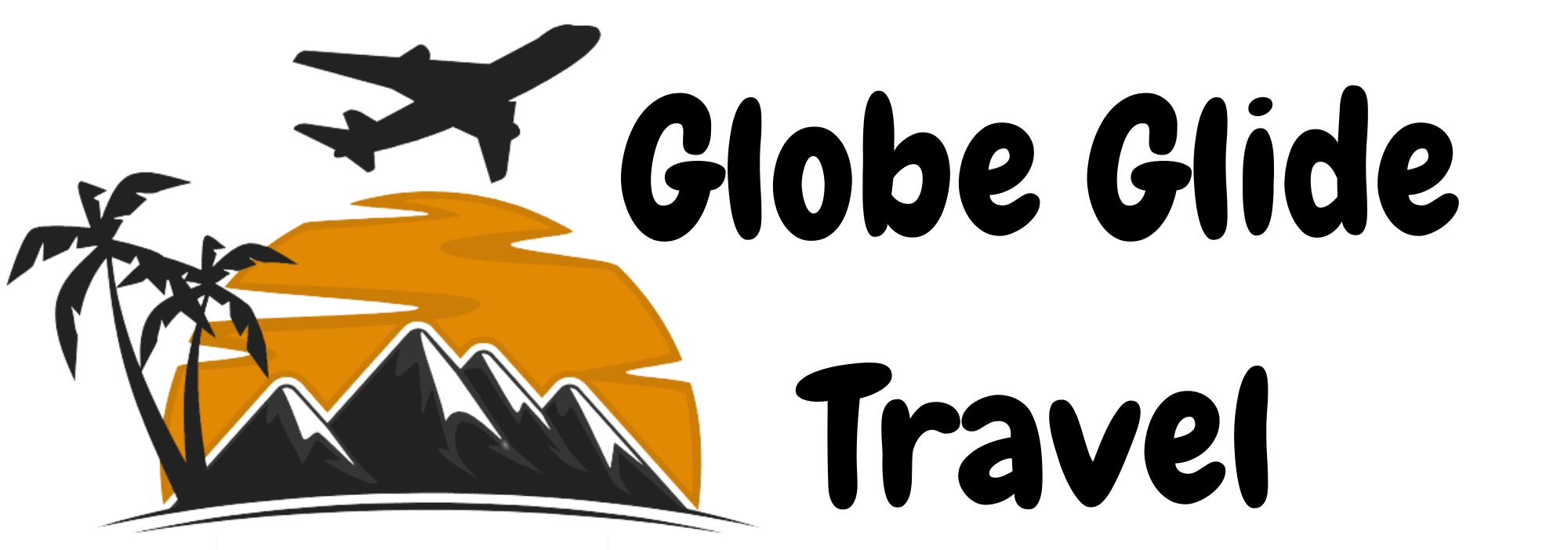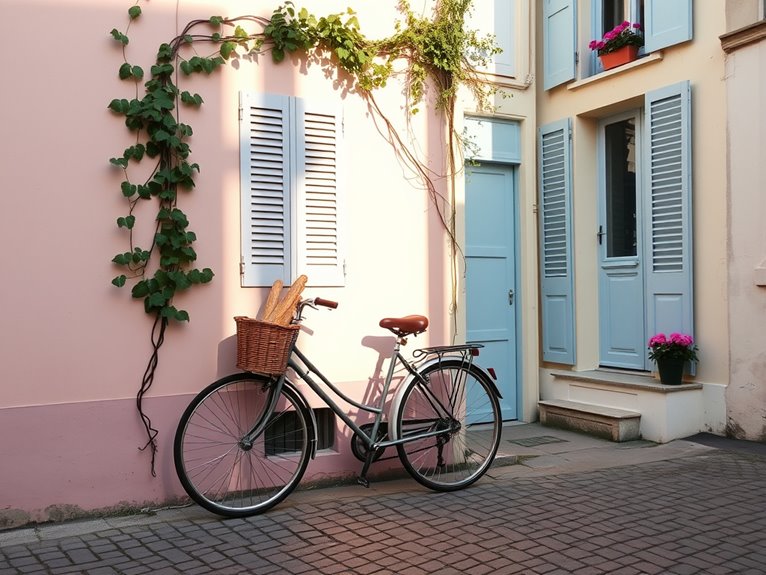
10 Most Photogenic Streets in Paris for Your Instagram
I've discovered the most Instagram-worthy streets in Paris, and you're going to love them! Start with Rue De L'abreuvoir in Montmartre, where La Maison Rose's pink facade creates perfect morning shots. Don't miss Rue Crémieux's rainbow-colored houses or Avenue Rapp's stunning Art Nouveau architecture. For iconic Eiffel Tower views, head to Rue Saint-Dominique, and capture medieval charm on Rue Des Barres. Each street holds its own photography secrets, timing tips, and hidden spots waiting to be explored.
Rue De L'abreuvoir: Montmartre's Most Charming Corner
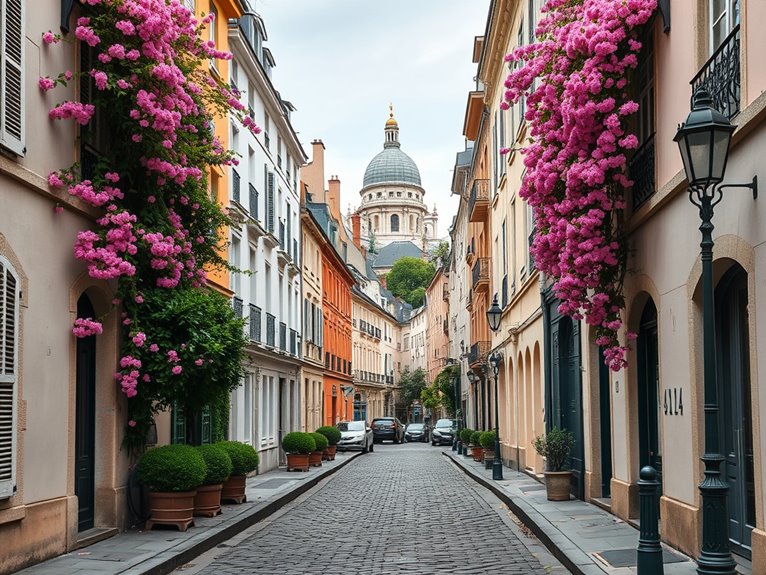
Tucked away in the heart of Montmartre, Rue de l'Abreuvoir stands as one of Paris's most photographed streets, offering a quintessentially French backdrop that captures the romantic essence of the city. This cobblestone street, with its iconic pink house La Maison Rose at the corner, has become a magnet for photographers and Instagram enthusiasts seeking to capture the perfect Parisian moment.
The street's name, meaning "watering trough" in French, hints at its historical significance as a place where horses once stopped to drink. Today, it's transformed into a picturesque haven where ivy-covered facades, traditional lampposts, and charming cafés create an atmospheric setting that epitomizes the artistic spirit of Montmartre.
Quick Facts:
- Best Photography Hours: Early morning (6-8 AM) or golden hour (1-2 hours before sunset)
- Crowd Levels: Heavy between 10 AM – 6 PM
- Street Length: Approximately 130 meters
- Nearest Metro: Lamarck-Caulaincourt (Line 12)
- Best Photography Seasons: Spring (April-May) and Fall (September-October)
- Notable Landmarks: La Maison Rose, Vue de Montmartre
Main Features:
La Maison Rose stands as the street's crown jewel, a pink-painted restaurant immortalized in numerous paintings by Maurice Utrillo. Located at number 2, this establishment dates back to 1905 and offers both a perfect photo opportunity and authentic French cuisine. The best shots are captured from the opposite corner during early morning hours.
The distinctive cobblestone path creates leading lines perfect for photography, with the gentle slope offering varied perspectives of Sacré-Cœur in the background. The street's slight curve adds depth to photographs, while the traditional Parisian architecture provides endless framing possibilities.
The intersection with Rue des Saules presents one of the area's most iconic views, featuring ancient lamp posts and the famous Montmartre vineyard. This spot is particularly magical during autumn when the vineyard's foliage turns golden.
Pro Tips:
For the most stunning photographs, visit during "blue hour" (just before sunrise) when the street lamps are still lit but the sky begins to brighten. Position yourself at the bottom of the street looking up for the most dramatic composition, incorporating the curved line of buildings and the charming lampposts. Consider using a wide-angle lens to capture the street's full character while maintaining the intimate feel of the narrow passage.
Practical Advice:
While Rue de l'Abreuvoir is public and accessible 24/7, respect local residents by maintaining quiet, especially during early morning shoots. Many cafés don't open until 10 AM, so plan accordingly if you want to include open businesses in your photos. Tripods are allowed but can be cumbersome during busy hours. Consider visiting on weekdays to avoid the weekend crowds, and always be prepared for unexpected weather changes that could enhance or challenge your photography experience.
Rue Crémieux: The Rainbow-Colored Hidden Gem
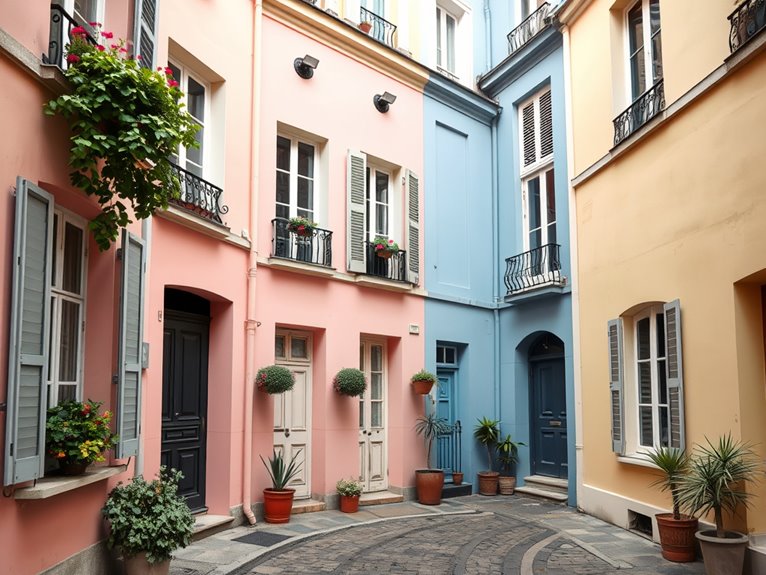
Tucked away in the 12th arrondissement of Paris, Rue Crémieux stands as one of the city's most Instagram-worthy streets, enchanting visitors with its row of pastel-painted houses and charming architectural details. This 144-meter-long pedestrian street has transformed from a quiet residential lane into a social media sensation, with its colorful facades ranging from soft pink and sunny yellow to powder blue and mint green.
Originally built in the 1850s as worker housing, this cobblestone street now represents a flawless blend of historical charm and modern appeal. Each house along Rue Crémieux tells its own story through distinctive shutters, flowering window boxes, and artistically painted doors, creating a uniquely photogenic urban landscape that rivals the famous painted houses of Notting Hill or Burano.
Quick Facts:
- Best Photography Hours: Early morning (7-9 AM) or golden hour (just before sunset)
- Street Access: Open 24/7, but residents prefer visitors between 9 AM-7 PM
- Nearest Metro: Gare de Lyon (Lines 1, 14, RER A and D)
- Photography Restrictions: No commercial photography without permits
- Best Season: Spring and summer for ideal natural lighting
- Crowd Levels: Moderate to heavy during midday, especially weekends
Location and Access:
The street runs parallel to Rue de Lyon, between Rue de Bercy and Boulevard Diderot. While the street itself has no admission fee, visitors should note that this is primarily a residential area where locals live and work. The compact nature of the street means it can be explored in 15-30 minutes, though photographers might want to allocate more time.
Insider Tip: Local residents have installed artistic cat sculptures and quirky decorations in various windows – these change periodically and make for unique photo opportunities that most tourists miss while focusing on the famous facades.
Pro Tips:
For the best photography experience, visit on overcast days when the soft light brings out the pastel colors without harsh shadows. Consider using a wide-angle lens to capture entire house facades, and position subjects in doorways or against complementary colored walls for striking portraits. Weekday mornings typically offer the most peaceful atmosphere for photography, while weekends can bring crowds of influencers and tourists.
To respect local residents and maintain the street's preservation, keep appropriate noise levels, avoid blocking doorways or windows, and limit photography sessions to reasonable durations. Some residents have become increasingly protective of their privacy, so always ask permission before photographing specific properties or including people in your shots.
Rue Des Barres: Medieval Paris Frozen in Time
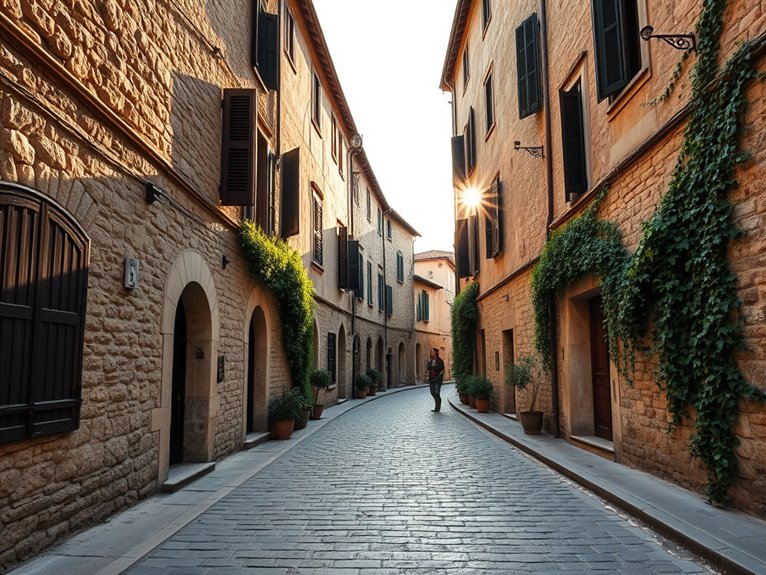
Photogenic Streets in Paris: Rue Des Barres
Medieval Paris Frozen in Time
Tucked away in the Marais district, Rue des Barres stands as a pristine example of medieval Paris, offering photographers and history enthusiasts a glimpse into the city's past. This cobblestone street, dating back to the 13th century, winds between ancient buildings and provides a perfect backdrop for capturing timeless Parisian moments on camera.
The street's unique charm lies in its well-preserved architecture, featuring gothic elements, wooden beams, and weathered stone walls that create a dramatic interplay of light and shadow throughout the day. Connecting Rue François Miron to Rue du Pont Louis-Philippe, this hidden gem offers unparalleled photo opportunities with its authentic medieval character and minimal modern intrusions.
Quick Facts:
- Best Photography Times: Early morning (7-9 AM) or late afternoon (4-6 PM)
- Street Length: Approximately 150 meters
- Nearest Metro: Hôtel de Ville (Line 1)
- Best Season: Spring and Fall for ideal lighting
- Photography Permits: Not required for personal photography
- Crowd Levels: Minimal during weekdays, moderate on weekends
The Historic Church View
Saint-Gervais-Saint-Protais Church dominates one end of Rue des Barres, providing a stunning focal point for photographs. The 16th-century gothic church creates a dramatic backdrop, particularly during golden hour when its limestone façade glows warmly. Position yourself at the lower end of the street for the most impressive composition incorporating both the church and the medieval buildings.
The Medieval Houses
The street's northern section features some of Paris's oldest residential buildings, with distinctive architectural elements from the 14th and 15th centuries. Look for the house at number 8, which showcases original wooden beams and a restored medieval façade. These buildings are best photographed in the early morning when the rising sun creates interesting shadows across their ancient surfaces.
The Hidden Courtyard
Midway along Rue des Barres, an often-overlooked passageway leads to a quiet courtyard that offers additional photo opportunities. This secret spot provides a perfect frame for capturing the street's medieval atmosphere without modern interruptions. The courtyard is accessible during daylight hours but respect that some areas are private residences.
Pro Tips:
Visit on overcast days for even lighting that helps capture architectural details without harsh shadows. Consider using a wide-angle lens to capture the narrow street's full character while maintaining perspective. For the most atmospheric shots, photograph after a light rain when the cobblestones reflect light and add depth to your images. Avoid using flash photography, as the natural light interaction with the historic surfaces creates more authentic results.
Practical Advice:
Wear comfortable shoes with good grip, as the cobblestones can be slippery, especially after rain. While the street is generally quiet, be mindful of residents and other photographers. Some buildings are private residences, so maintain a respectful distance when photographing. Consider visiting during shoulder seasons (April-May or September-October) when tourist numbers are lower and the lighting conditions are suitable for photography.
Avenue Rapp: Art Nouveau Architecture Paradise
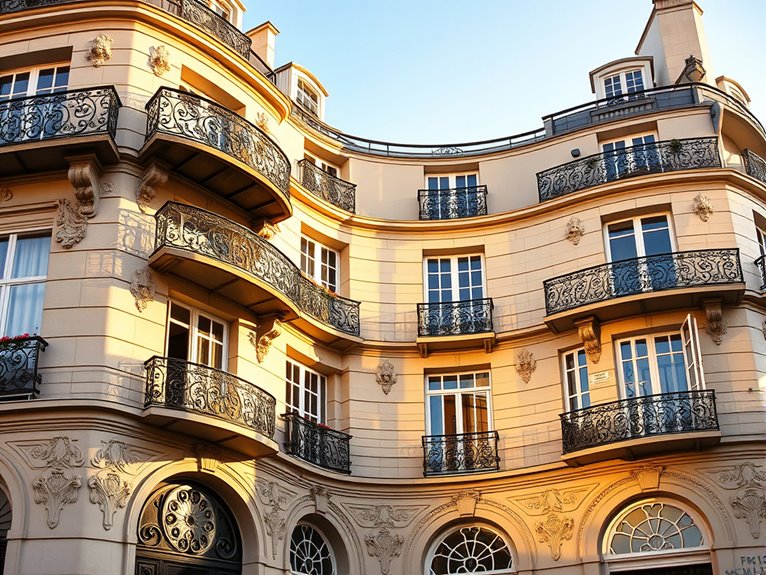
Avenue Rapp stands as one of Paris's most spectacular showcases of Art Nouveau architecture, offering photographers and architecture enthusiasts an unparalleled collection of ornate buildings from the early 20th century. This elegant street in the 7th arrondissement, stretching from Quai Branly to Rue Saint-Dominique, is home to some of the most photographed façades in Paris, including the iconic 29 Avenue Rapp with its famous porthole window designed by Jules Lavirotte.
The street gained prominence during the Art Nouveau movement (1890-1910) when architects like Lavirotte transformed ordinary buildings into extraordinary works of art, incorporating organic forms, curved lines, and nature-inspired elements. Today, these architectural masterpieces provide ideal backdrops for Instagram photos, particularly during golden hour when the intricate details catch the soft light.
Quick Facts:
- Best visiting hours: 7-9 AM or 5-7 PM for ideal lighting
- Photography permits: Not required for exterior shots
- Prime season: Spring and fall for best natural lighting
- Closest Metro: Alma-Marceau (Line 9)
- Walking time: 15-20 minutes to explore the entire avenue
- Best camera angles: Wide-angle lens recommended
- Building access: Exteriors only (private residences)
Notable Highlights:
29 Avenue Rapp
The crown jewel of the street, this building features an extraordinary entrance way with sculptural elements including peacocks, salamanders, and floral motifs. The famous oval window, designed to resemble a giant eye, is surrounded by intricate stone carvings. The building won the 1901 Paris facade competition and remains the most photographed structure on the avenue.
Lavirotte Building at 3 Square Rapp
Just off Avenue Rapp, this lesser-known but equally impressive building showcases more of Lavirotte's signature style. The entrance features elaborate ceramic decorations and symbolist sculptures. Insider tip: Visit early morning when the sun illuminates the eastern façade, bringing out the rich colors of the ceramics.
Art Nouveau Details
Throughout the street, look for characteristic elements like curved iron balconies, nature-inspired stonework, and colorful ceramic tiles. Pay special attention to the doorways, as they often feature the most elaborate decorations. Hidden gem: Several buildings feature original period house numbers with distinctive Art Nouveau typography.
Pro Tips:
For the best photographs, visit during early morning hours when the street is quiet and the light is soft. Position yourself across the street from your target building to capture the full façade, and don't forget to look up – some of the most interesting details are above eye level. Consider using HDR photography techniques to capture both the intricate details in shadows and the bright highlights of the buildings.
Practical Advice:
While Avenue Rapp is a public street, remember that all buildings are private residences. Maintain a respectful distance when photographing, and avoid blocking entrances or disturbing residents. Tripods are generally acceptable but may draw attention from security personnel during busy hours. Consider combining your visit with nearby attractions like the Eiffel Tower or Quai Branly Museum to maximize your time in the area.
Rue Des Rosiers: Le Marais' Historic Jewish Quarter
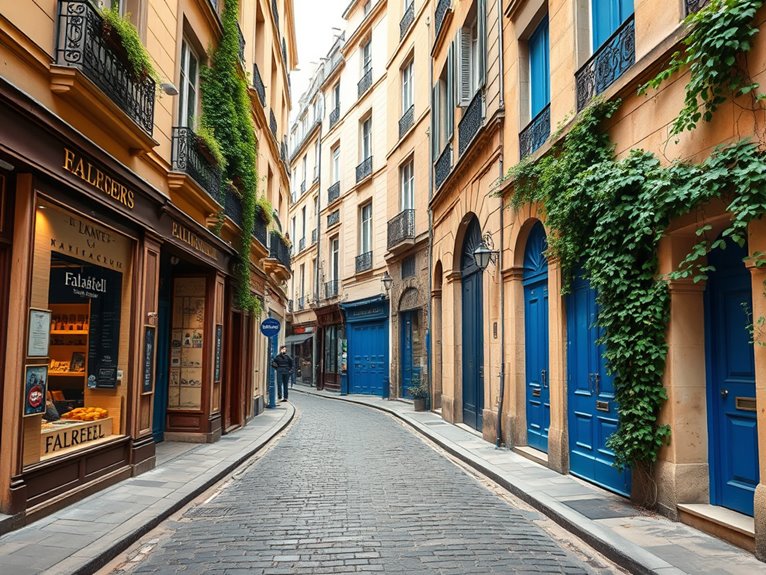
Photogenic Streets in Paris: Rue Des Rosiers
——————————————
Tucked away in the heart of Le Marais, Rue des Rosiers stands as a vibrant representation of Paris's historic Jewish quarter, where centuries-old traditions blend seamlessly with contemporary urban life. This cobblestone street, whose name translates to "Street of the Rosebushes," captivates photographers and culture enthusiasts alike with its distinctive mix of medieval architecture, boutique storefronts, and authentic Jewish delis.
From its distinctive Hebrew signage to the enticing aromas of freshly baked challah and falafel, Rue des Rosiers offers an immersive cultural experience that makes it one of Paris's most photogenic and historically significant streets. The narrow passage, dating back to the 13th century, provides endless opportunities for capturing authentic Parisian moments, from local residents going about their daily routines to the striking contrast between ancient stone walls and modern street art.
Quick Facts:
- Best Photography Hours: Early morning (7-9 AM) or late afternoon (4-6 PM)
- Most Shops Open: 11 AM – 7 PM (Closed Saturdays)
- Peak Tourist Times: 12 PM – 3 PM daily
- Street Length: Approximately 400 meters
- Photography Permits: Not required for personal use
- Notable Features: Medieval architecture, Jewish bakeries, vintage boutiques
- Best Light Direction: Morning light from east end, afternoon from west
Key Photography Spots:
L'As du Fallafel (#34)
This world-famous falafel restaurant isn't just about food – its distinctive green facade and perpetual queue create perfect street photography opportunities. The contrast of the bright storefront against the medieval stone buildings makes for compelling compositions, especially during golden hour.
Sacha Finkelsztajn's Bakery (#27)
The golden Art Deco storefront of this historic Jewish bakery provides an excellent focal point for street photography. Capture the display of traditional pastries through the window or frame shots of locals emerging with their fresh bread purchases.
Medieval Archway (Junction with Rue Vieille du Temple)
The preserved medieval entrance offers a unique architectural frame for photos, particularly effective when shooting towards the setting sun. The worn stone texture and gothic details provide excellent foreground elements for street scenes.
Pro Tips:
For the most atmospheric shots, visit during light rain when the cobblestones reflect the historic buildings and shop lights. Position yourself at the corners of intersecting streets to capture the full character of the narrow passage, and include people in your frames for scale and authenticity. The street's best angles emerge when shot from a low position, emphasizing the towering medieval buildings and creating leading lines with the cobblestones.
Practical Advice:
Respect the local Jewish community, particularly during religious holidays and Saturdays when many businesses are closed. Some shopkeepers prefer not to have their storefronts photographed, so always ask permission when shooting close-up details. Carry a wide-angle lens for architecture shots and a 50mm for street photography, but be mindful of the narrow sidewalks and frequent pedestrian traffic. Early morning visits offer the best combination of good light and minimal crowds for unobstructed architectural shots.
Rue De La Huchette: Latin Quarter's Medieval Heart

Nestled in Paris's 5th arrondissement, Rue de la Huchette stands as a living representation of medieval Paris, where centuries-old buildings lean inward and weathered cobblestones tell stories of countless footsteps. This narrow street, barely 200 meters long, captures the essence of old Paris with its theatrical heritage, bustling restaurants, and photogenic charm that makes it an Instagram favorite.
The street's authentic medieval character, combined with its vibrant modern energy, creates an irresistible backdrop for photography enthusiasts. From the iconic Theatre de la Huchette, home to the world's longest-running play, to the warm glow of traditional Greek tavernas and the intricate architectural details dating back to the 13th century, every angle offers a glimpse into both historical and contemporary Parisian life.
Quick Facts:
- Best Photography Hours: Early morning (6-8 AM) or golden hour (1 hour before sunset)
- Peak Tourist Times: 11 AM – 9 PM
- Street Length: Approximately 200 meters
- Notable Features: Medieval architecture, theatre, restaurants
- Nearest Metro: Saint-Michel Notre-Dame (Lines 4, RER B, and RER C)
- Photography Challenges: Heavy foot traffic, narrow space
- Best Seasons: Spring and Fall for ideal lighting and fewer crowds
Notable Photography Spots:
Theatre de la Huchette
This historic theater's facade, with its classic red signage and art deco elements, provides a quintessential Parisian shot. The theatre has been running Ionesco's plays since 1957, and its vintage character makes it particularly photogenic during blue hour when the neon signs illuminate against the darkening sky. Insider tip: Frame your shot from the slight elevation near Rue du Chat-qui-Pêche for a more dramatic perspective.
Restaurant Row
The concentration of Greek restaurants with their blue and white awnings, hanging plants, and outdoor seating creates a charming Mediterranean atmosphere in the heart of Paris. The warm lighting from the restaurants' interiors creates an especially appealing ambiance after sunset. Insider tip: Some restaurant owners will allow early morning photography of their facades if you ask politely and purchase breakfast.
Medieval Architecture Details
The street's medieval buildings feature original timber frames, carved stone details, and slanting walls that create fascinating geometric patterns. Look for the building at number 3, which dates to 1600 and showcases some of the best-preserved medieval architectural elements. Insider tip: Use the early morning light to capture the textures and shadows of these ancient structures.
Pro Tips:
For the best Instagram shots, arrive before 7 AM when the street is nearly empty and the morning light creates a magical atmosphere. Use the narrow width of the street to your advantage by creating leading lines that draw the viewer's eye through your composition. Consider visiting during light rain, when the wet cobblestones reflect the surrounding lights and create additional visual interest.
Practical Advice:
While photographing, remain aware of delivery vehicles that frequently use the street in early morning hours. Keep your equipment minimal as the narrow sidewalks can get crowded quickly. Consider a wide-angle lens (16-35mm) to capture the full character of the street in tight spaces, and always ask permission before photographing restaurant interiors or including people in your shots.
Rue Montorgueil: Classic Parisian Market Street
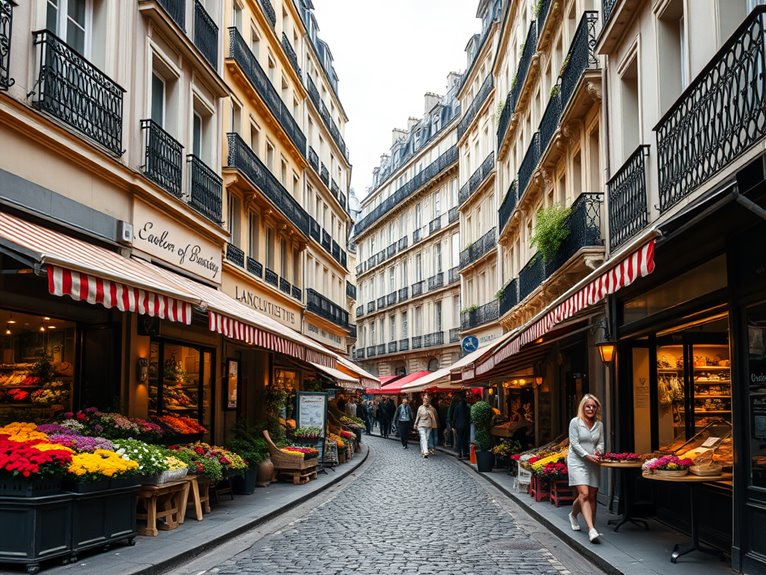
Nestled in the 2nd arrondissement, Rue Montorgueil stands as one of Paris's most cherished market streets, offering a quintessential glimpse into authentic Parisian life. This pedestrianized thoroughfare, stretching from Rue Réaumur to Rue Etienne Marcel, buzzes with the energy of local shoppers, café patrons, and food enthusiasts exploring its renowned specialty shops and eateries.
Dating back to the 12th century, this historic street has evolved from a simple pathway into a vibrant cultural hub, maintaining its traditional market atmosphere while embracing modern Parisian life. The cobblestone street features some of the city's oldest and most prestigious food establishments, including the legendary Stohrer patisserie, founded in 1730 by King Louis XV's pastry chef.
Quick Facts:
- Best Photography Hours: Early morning (8-10 AM) or golden hour (1 hour before sunset)
- Peak Market Times: Tuesday-Saturday, 9 AM-1 PM
- Notable Features: Cobblestones, historic storefronts, café terraces
- Photography Tips: Wide-angle lens recommended, early morning for fewer crowds
- Accessibility: Métro stations Les Halles or Sentier
- Best Days: Tuesday-Saturday (when most shops are open)
The Market Experience
The street comes alive with its diverse array of food merchants, including fromageries, boulangeries, fish markets, and produce stands. The most photogenic spots include the classic striped awnings of fish vendors, the colorful fruit displays, and the ornate façades of historic shops. Shops typically operate from 8 AM to 8 PM, with some restaurants staying open until midnight.
Pro Tips:
For the most Instagram-worthy shots, arrive before 9 AM when shopkeepers are setting up their displays and morning light creates a magical atmosphere. Position yourself at the intersection of Rue Montorgueil and Rue Tiquetonne for a perfect composition that captures the street's gentle curve and historic buildings. Consider visiting on weekday mornings to avoid weekend crowds that can make photography challenging.
Practical Advice:
While photographing, be mindful of local shoppers and residents going about their daily routines. Ask permission before taking close-up shots of shop displays or vendors, and consider making small purchases to support local businesses. The street can be particularly crowded during lunch hours (12-2 PM) and weekend afternoons, so plan your photo session accordingly. Weather-worn cobblestones can be slippery when wet, so wear appropriate footwear, especially if carrying camera equipment.
Rue Saint-Dominique: Perfect Eiffel Tower Views
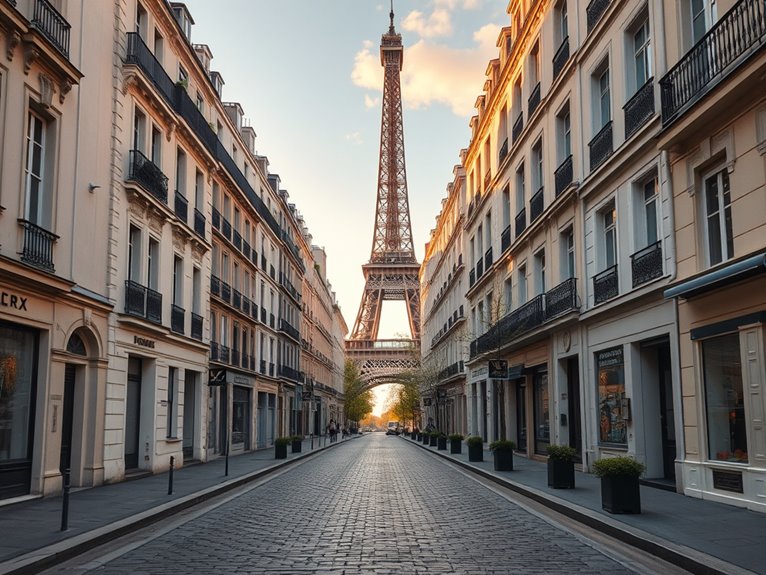
Rue Saint-Dominique stands as one of Paris's most picturesque streets, offering postcard-perfect views of the Eiffel Tower that have made it a favorite among photographers and Instagram enthusiasts. This charming thoroughfare in the 7th arrondissement stretches for nearly a mile, combining quintessential Parisian architecture with unobstructed vistas of France's most iconic monument.
What sets Rue Saint-Dominique apart is its unique positioning, allowing photographers to capture the Iron Lady framed by classic Haussmann buildings, ornate street lamps, and quintessentially French cafés. The street's gentle curve and wide sidewalks create multiple vantage points, each offering a distinctive perspective of the tower, particularly stunning during golden hour when the surrounding limestone buildings take on a warm, honey-colored glow.
Quick Facts:
- Best Photography Times: Sunrise (6-8 AM) and Golden Hour (1 hour before sunset)
- Street Length: 1.6 kilometers
- Nearest Metro: École Militaire or La Tour-Maubourg
- Best Photo Spots: Between #125 and #169 Rue Saint-Dominique
- Crowd Levels: Moderate to high during midday, low during early morning
- Camera Requirements: Wide-angle lens recommended (16-35mm)
The Most Popular Photo Spot
The section between numbers 125 and 169 offers the most striking views of the Eiffel Tower. This stretch presents perfect framing opportunities where the tower appears to rise majestically between the buildings. The surrounding architecture features typical Parisian balconies and ornate facades, adding depth and context to your photographs. Insider tip: The small café at number 144 has a perfectly positioned terrace for capturing elevated shots while enjoying a morning coffee.
Secondary Vantage Points
Walking east to west, several "reveal" moments occur where the tower suddenly appears between buildings. The intersection with Avenue Bosquet provides a unique diagonal view, while the corner of Rue Cler offers a charming market-street foreground. Little-known secret: The entrance of the École Militaire provides an elevated platform perfect for unobstructed shots during quiet morning hours.
Pro Tips:
Early morning visits, particularly on weekdays, offer the best combination of lighting and minimal crowd interference. The street comes alive with locals around 8 AM, creating authentic Parisian street scenes perfect for environmental portraits. Consider visiting during light rain – the wet cobblestones create beautiful reflections, and the moody atmosphere adds drama to your images. For the best results, shoot in RAW format to capture the subtle color variations in the limestone buildings and metal structure of the tower.
Practical Advice:
While Rue Saint-Dominique is primarily residential, respect local privacy and business operations when photographing. Several cafés welcome photographers but expect patronage in exchange for prime photo spots. Tripods are generally tolerated during off-peak hours but should be used considerately to avoid blocking pedestrian traffic. Keep in mind that the Eiffel Tower's sparkle show is copyrighted when photographed at night – these images cannot be commercially used without permission.
Rue Nicolas Flamel: The Oldest Street in Paris
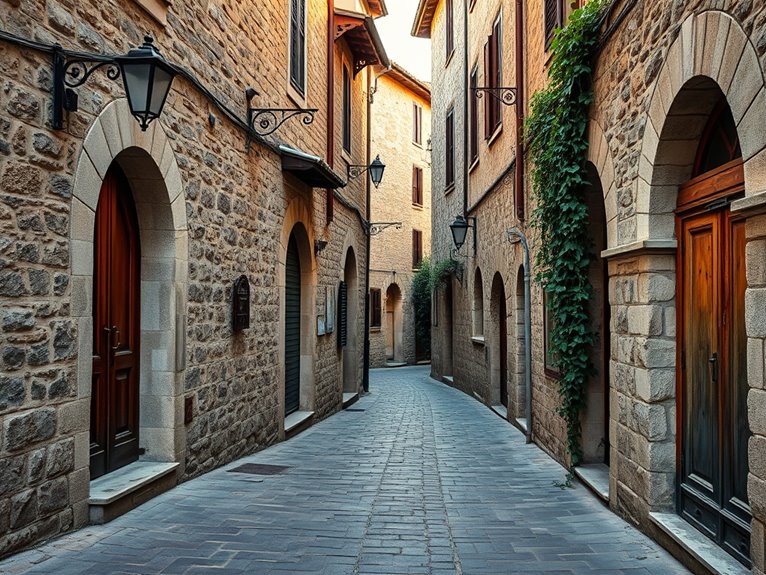
Photogenic Streets in Paris: Rue Nicolas Flamel
——————————————
Stepping onto Rue Nicolas Flamel feels like traveling back through centuries of Parisian history. Named after the famous medieval alchemist Nicolas Flamel, this narrow street in the Marais district stands as the oldest recorded street in Paris, dating back to 1290. Its weathered stone buildings, original architectural details, and mysterious atmosphere make it an irresistible destination for photographers seeking to capture authentic medieval Paris.
The street's photogenic appeal lies in its perfectly preserved medieval character, complete with ancient doorways, worn cobblestones, and decorative elements that hint at its alchemical past. Modern visitors can trace the footsteps of Nicolas Flamel himself, who owned several properties along this street and whose legacy inspired countless stories, including mentions in Harry Potter literature.
Quick Facts:
- Best Photography Hours: Early morning (6-8 AM) or golden hour (1 hour before sunset)
- Street Length: Approximately 130 meters
- Closest Metro: Châtelet-Les Halles (Lines 1, 4, 7, 11, 14)
- Best Season: Spring/Fall for ideal lighting and fewer tourists
- Photography Permits: Not required for personal photography
- Key Features: Medieval architecture, original stone carvings, historic plaques
Historical Significance:
The street's most notable building is at number 51, Nicolas Flamel's house built in 1407, now operating as L'Auberge Nicolas Flamel. The façade features original carved symbols and inscriptions that allegedly contain alchemical secrets. The building stands as Paris's oldest stone house and represents one of the finest examples of 15th-century civilian architecture in the city.
Insider Tip: Look for the subtle carved symbols near the doorways – these aren't mere decorations but are believed to be alchemical codes left by Flamel himself. The best photos capture these details during morning light when shadows create dramatic contrast.
Pro Tips:
For the most atmospheric photographs, visit during or just after rain when the cobblestones reflect light and create a mystical ambiance. Position yourself at the northern end of the street looking south for the best composition, incorporating the dramatic perspective of narrowing medieval buildings. Consider using a wide-angle lens to capture the full vertical scope of the architecture while maintaining the intimate feel of the street.
Practical Advice:
While the street is public and accessible 24/7, respect the privacy of current residents and businesses. The narrow sidewalks can get crowded during peak tourist hours (11 AM – 4 PM), so early morning visits are recommended for unobstructed photos. Bring a tripod for low-light situations, but be prepared to move it frequently as local traffic passes through this active street.
Rue De L'université: Quintessential Haussmann Beauty
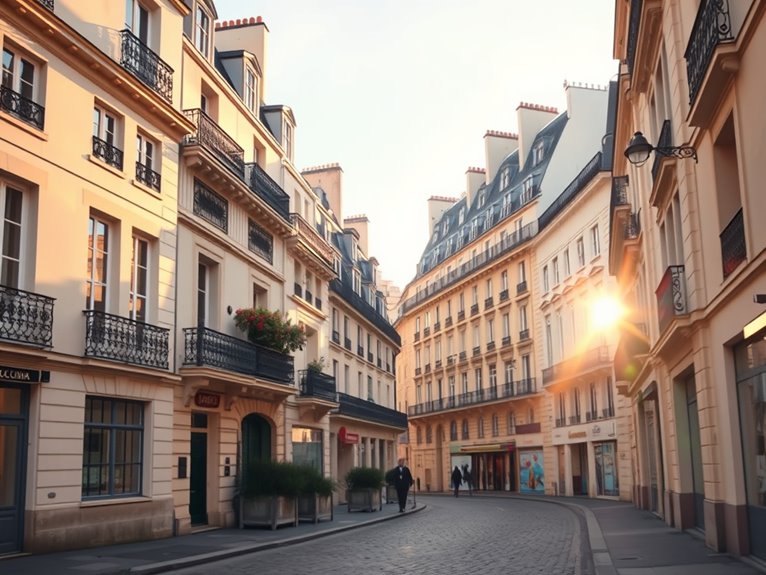
Photogenic Streets in Paris: Rue De L'université
——————————————
Rue de l'université stands as one of Paris's most photographed streets, embodying the archetypal Haussmann architecture that defines the city's romantic aesthetic. Stretching through the prestigious 7th arrondissement, this historic thoroughfare offers unparalleled views of the Eiffel Tower framed by elegant limestone buildings and classic Parisian balconies.
Photographers and Instagram enthusiasts flock to this location for its perfect composition of Parisian elements: wrought-iron balconies, uniform cream-colored facades, and the iconic tower looming in the background. The street's gentle curve and perfectly maintained buildings create leading lines that draw the eye naturally toward the Iron Lady, making it nearly impossible to take a bad photo.
Quick Facts:
- Best Photography Hours: 7-9 AM (sunrise) or 6-8 PM (golden hour)
- Quietest Times: Early morning weekdays
- Nearest Metro: Invalides or Solférino
- Best Photo Spot: Between 184-188 Rue de l'université
- Walking Distance: 20 minutes from the Eiffel Tower
- Photography Permits: Not required for personal use
The Classic Tower View
Located between numbers 184-188, this stretch offers the most iconic view of the Eiffel Tower. The buildings here maintain their original Haussmann details, including ornate doorways and perfectly preserved balconies. This specific location allows photographers to capture the tower perfectly centered between the buildings, creating a symmetrical frame that's become a social media sensation.
The Hidden Courtyard Entrance
At number 192, an often-overlooked ornate doorway leads to one of the street's most photogenic private courtyards. While the courtyard itself is private, the entrance arch creates a stunning frame for architectural photos, especially during morning hours when light streams through from the east.
The Historic Facades
Between numbers 195-205, the buildings showcase some of the finest examples of preserved Haussmann architecture in Paris. The uniform height, cream-colored stone, and matching wrought-iron work create a harmonious streetscape that's particularly striking in photos, especially during the golden hour.
Pro Tips:
For the best shots, arrive before sunrise to catch the warm morning light and avoid tourists. Consider using a wide-angle lens (24-35mm) to capture both the street's architecture and the Eiffel Tower in one frame. On overcast days, the diffused light can actually enhance the cream-colored buildings' details, making it an excellent time for architectural close-ups.
Practical Advice:
Remember that this is a residential street, so maintain respectful noise levels and avoid blocking doorways while photographing. Many of the best shots require patience as delivery vehicles and cars frequently park along the street. Consider visiting during weekends when traffic is lighter, and bring a tripod for low-light morning shots, but be mindful not to obstruct pedestrian traffic on the narrow sidewalks.
